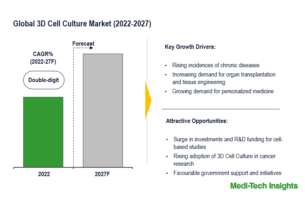The expansion of the HIV diagnostics market is driven by several key factors that contribute to its growth trajectory. One significant factor is the ongoing prevalence of HIV/AIDS globally, necessitating a continual demand for diagnostic tests to address this persistent health challenge. Advances in technology have led to the development of innovative diagnostic tools with improved sensitivity, specificity, and ease of use. These include rapid diagnostic tests (RDTs), molecular diagnostics, and novel biomarker detection methods, enhancing the accuracy and efficiency of HIV diagnosis. Rising awareness about HIV/AIDS and the importance of early detection, coupled with screening programs initiated by governments, NGOs, and healthcare organizations, have led to increased testing uptake among individuals, fostering market growth. Moreover, improvements in healthcare infrastructure, particularly in developing regions, have facilitated better access to diagnostic services, contributing to the overall expansion of the market. These factors collectively underscore the dynamic nature of the HIV diagnostics market, which is poised for further evolution with ongoing advancements in technology and healthcare delivery systems. For instance,
- In December 2022, Gilead Sciences, Inc. revealed that Sunlenca (lenacapavir), alongside other antiretroviral (ARV), received approval from the U.S. Food and Drug Administration (FDA) for treating HIV-1 infection in heavy treatment-experienced (HTE) adults with multi-drug resistant (MDR) HIV-1 infection
- In February 2022, ViiV Healthcare announced the approval by the US Food and Drug Administration (FDA) of Cabenuva (cabotegravir, rilpivirine) for the treatment of HIV-1 in virologically suppressed adults, with dosing intervals extended to every two months
Expanding Horizons: Developments and Initiatives in HIV Diagnostics Market
The HIV diagnostics market is witnessing significant developments, particularly in the domain of point-of-care testing (POCT). The rise of POCT for HIV diagnostics is driven by its rapid turnaround time, facilitating early diagnosis and intervention, a crucial advantage, especially in resource-constrained settings with limited access to traditional laboratory facilities. There is a concerted effort to expand HIV diagnostics markets in developing regions with a high burden of HIV/AIDS. Governments, NGOs, and international entities are investing in initiatives aimed at improving access to diagnostic services, thereby stimulating market growth in these regions. For instance,
- In January 2022, Vela Diagnostics revealed that its Sentosa SQ HIV-1 Genotyping Assay has gained reimbursement coverage from The Centers for Medicare and Medicaid (CMS) in the US. This assay significantly decreases technician involvement compared to conventional methods using Sanger sequencing, necessitating less than 2 hours of hands-on time from sample collection to report generation
Integration of HIV diagnostics into existing healthcare frameworks, such as antiretroviral therapy (ART) programs and maternal and child health services, streamlines early detection and access to care, fostering improved patient outcomes and expanding market reach. Diversification of HIV testing services beyond conventional healthcare settings to community-based, outreach, and non-clinical settings like pharmacies and mobile clinics opens up new avenues for market expansion, enhancing accessibility and convenience for individuals seeking testing services. Additionally, the adoption of multiplex testing platforms capable of detecting multiple infections concurrently, including HIV, is gaining momentum, particularly in settings where co-infections are prevalent, further propelling growth within the HIV diagnostics market.HIV Diagnostics Market: Key Constraints/Challenges
The HIV diagnostic market encounters various challenges that can hinder its efficiency and expansion. One significant obstacle is the high cost of diagnostic tests, particularly with newer and more advanced technologies, potentially limiting widespread testing initiatives and early detection efforts. Additionally, pediatric testing poses unique challenges, including the need for specialized methods and the risk of false-positive or false-negative results, requiring improved access and accurate diagnosis for timely interventions, especially in preventing mother-to-child transmission. Moreover, the emergence of drug-resistant HIV strains presents diagnostic difficulties as traditional methods may fail to detect these strains accurately, emphasizing the importance of ongoing surveillance to inform treatment decisions and effectively manage HIV infections. Addressing these challenges requires collaborative efforts to enhance access, accuracy, and affordability of diagnostic testing while adapting to evolving HIV strains and pediatric testing needs.Regional Segmentation of the Autoimmune Disease Diagnosis Market
In North America, well-established healthcare infrastructure, technological advancements, and significant investments in HIV/AIDS prevention and treatment programs contribute to a robust market. This region also benefits from, stringent regulatory frameworks, and government initiatives aimed at controlling HIV/AIDS spread. Similarly, Europe showcases advanced healthcare systems, facilitating widespread access to diagnostic services. The market here thrives on increasing awareness, favorable reimbursement policies, and the presence of prominent market players focusing on innovative diagnostic technologies.In contrast, the Asia Pacific region faces a significant burden of HIV/AIDS, especially in countries like India, China, and Thailand. Changing socioeconomic conditions and demographics are contributing to a rise in HIV cases in these nations. Moreover, heightened investments in healthcare facilities and awareness initiatives are driving market expansion in the Asia Pacific region.HIV Diagnostics Market: Competitive Landscape
Some of the key players operating in the market include Siemens Healthineers, F. Hoffmann-La Roche Ltd, Abbott Laboratories, Danaher Corporation, Thermo-Fisher Scientific Inc., Merck KGaA, Becton, Dickinson & Company, Hologic Inc., Gilead Sciences Inc., Bio-Rad Laboratories, Qiagen and Mylan Inc among others.Get a Sample Report for Competitive Landscape AnalysisOrganic and Inorganic Growth Strategies Adopted by Players to Establish Their Foothold in the Market
Players operating in this market are adopting both organic and inorganic growth strategies such as collaborations, and acquisitions to garner market share. For instance,
- In August 2023, The Global Fund revealed a groundbreaking agreement with generic pharmaceutical companies aimed at substantially reducing the cost of a state-of-the-art HIV medication, a development expected to have a life-saving impact. The Global Fund, established in 2002 to combat AIDS, tuberculosis, and malaria, stated that this deal would enable the provision of the advanced TLD pill at less than $45 per person annually, marking a significant milestone in access to HIV treatment
- In August 2021, Weill Cornell Medicine received a $28.5 million Martin Delaney Collaboratory grant from the National Institutes of Health to spearhead a multi-institutional initiative focused on discovering a cure for HIV. Led by Dr Brad Jones, the program, named REACH: Research Enterprise to Advance a Cure for HIV, will be based at Weill Cornell Medicine and aims to advance research efforts in this field
The HIV diagnostics market is expected to gain momentum in the coming years due to the rising incidences of HIV infections, growing awareness about HIV/AIDS and the importance of early detection, technological advancements, and aggressive organic and inorganic growth strategies followed by the players.



